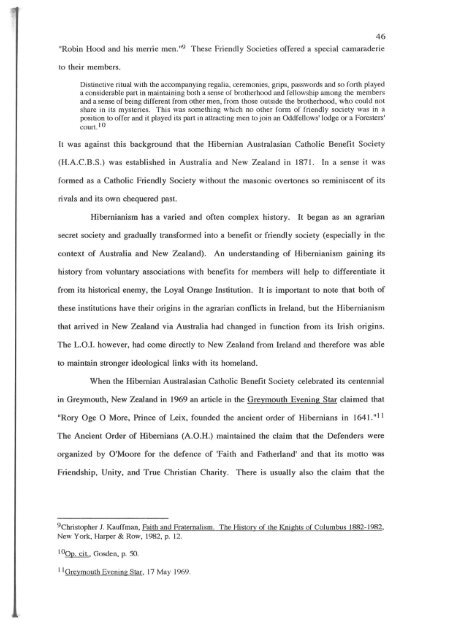TRANSPLANTED IRISH INSTITUTIONS - University of Canterbury
TRANSPLANTED IRISH INSTITUTIONS - University of Canterbury
TRANSPLANTED IRISH INSTITUTIONS - University of Canterbury
You also want an ePaper? Increase the reach of your titles
YUMPU automatically turns print PDFs into web optimized ePapers that Google loves.
"Robin Hood and his merrie men."9 These Friendly Societies <strong>of</strong>fered a special camaraderie<br />
to their members.<br />
Distinctive ritual with the accompanying regalia, ceremonies, grips, passwords and so forth played<br />
a considerable part in maintaining both a sense <strong>of</strong> brotherhood and fellowship among the members<br />
and a sense <strong>of</strong> being different from other men, from those outside the brotherhood, who could not<br />
share in its mysteries. This was something which no other form <strong>of</strong> friendly society was in a<br />
position to <strong>of</strong>fer and it played its part in attracting men to join an Oddfellows' lodge or a Foresters'<br />
court. 1 0<br />
It was against this background that the Hibernian Australasian Catholic Benefit Society<br />
46<br />
(H.A.C.B.S.) was established in Australia and New Zealand in 1871.<br />
In a sense it was<br />
fonned as a Catholic Friendly Society without the masonic overtones so reminiscent <strong>of</strong> its<br />
rivals and its own chequered past.<br />
Hibernianism has a varied and <strong>of</strong>ten complex history.<br />
It began as an agrarian<br />
secret society and gradually transformed into a benefit or friendly society (especially in the<br />
context <strong>of</strong> Australia and New Zealand).<br />
An understanding <strong>of</strong> Hibernianism gaining its<br />
history from voluntary associations with benefits for members will help to differentiate it<br />
from its historical enemy, the Loyal Orange Institution. It is important to note that both <strong>of</strong><br />
these institutions have their origins in the agrarian conflicts in Ireland, but the Hibernianism<br />
that arrived in New Zealand via Australia had changed in function from its Irish origins.<br />
The L.O.1. however, had come directly to New Zealand from Ireland and therefore was able<br />
to maintain stronger ideological links with its homeland.<br />
When the Hibernian Australasian Catholic Benefit Society celebrated its centennial<br />
in Greymouth, New Zealand in 1969 an article in the Greymouth Evening Star claimed that<br />
NRory Oge 0 More, Prince <strong>of</strong> Leix, founded the ancient order <strong>of</strong> Hibernians in 1641."11<br />
The Ancient Order <strong>of</strong> Hibernians (A.O.H.) maintained the claim that the Defenders were<br />
organized by O'Moore for the defence <strong>of</strong> 'Faith and Fatherland' and that its motto was<br />
Friendship, Unity, and True Christian Charity. There is usually also the claim that the<br />
9Christopher J. Kauffman, Faith and Fraternalism. The History <strong>of</strong> the Knights <strong>of</strong> Columbus 1882-1982,<br />
New York, Harper & Row, 1982, p. 12.<br />
lOOp. cit., Gosden, p. 50.<br />
I I Greymouth Evening Star, 17 May 1969.
















